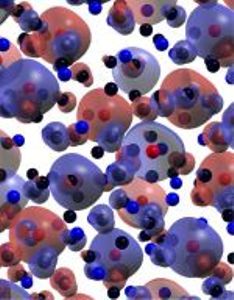May 18 2013
A new study discusses the electric and magnetic characteristics of a material which could be used in spintronics
 Positive (red) and negative (blue) isosurfaces of the magnetisation density of doped zirconia.
Positive (red) and negative (blue) isosurfaces of the magnetisation density of doped zirconia.
Materials belonging to the family of dilute magnetic oxides (DMOs) — an oxide-based variant of the dilute magnetic semiconductors — are good candidates for spintronics applications. This is the object of study for Davide Sangalli of the Microelectronics and Microsystems Institute (IMM) at the National Research Council (CNR), in Agrate Brianza, Italy, and colleagues. They recently explored the effect of iron (Fe) doping on thin films of a material called zirconia (ZrO2 oxide). For the first time, the authors bridged the gap between the theoretical predictions and the experimental measurements of this material, in a paper just published in EPJ B.
Spintronics exploit an intrinsic property of the electrons found in semi-conductors called spin, akin to the electrons’ degree of freedom. This determines the magnetic characteristics, known as magnetic moment, of the material under study. The challenge is to create such material with the highest possible temperature, as this will ensure that its magnetic properties can be used in room-temperature applications.
To study iron-doped zirconia, they examined its magnetic properties and its electronic structure from both a theoretical and experimental perspective. They then compared theory and experiments to find the most stable configuration of the material. Theoretical work included first-principles simulations. In parallel, their experimental work relied on many different well-established analytical techniques, including X-ray diffraction, X-ray photoelectron spectroscopy, transmission electron microscopy, and alternating gradient force magnetometer measurements.
Sangalli and colleagues therefore gained a better understanding of doped zirconia, which features oxygen vacancies, playing a crucial role in providing its unique electronic and magnetic characteristics. They have also predicted theoretically how the deviation from the standard structure influences this material’s properties. They are currently investigating, experimentally, how the magnetism evolves with changing concentrations of iron and oxygen vacancies to confirm theoretical predictions.
D. Sangalli et al . (2013), Exploiting magnetic properties of Fe doping in zirconia , European Physical Journal B, DOI 10.1140/epjb/e2013-30669-3